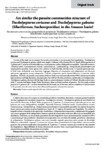Use este identificador para citar ou linkar para este item:
http://www.alice.cnptia.embrapa.br/alice/handle/doc/1043212Registro completo de metadados
| Campo DC | Valor | Idioma |
|---|---|---|
| dc.contributor.author | PANTOJA, W. M. de F. | pt_BR |
| dc.contributor.author | SILVA, L. V. F. | pt_BR |
| dc.contributor.author | TAVARES-DIAS, M. | pt_BR |
| dc.date.accessioned | 2016-04-12T11:11:11Z | pt_BR |
| dc.date.available | 2016-04-12T11:11:11Z | pt_BR |
| dc.date.created | 2016-04-12 | pt_BR |
| dc.date.issued | 2016 | pt_BR |
| dc.identifier.citation | Brazilian Journal of Veterinary Parasitology, Jaboticabal, v. 25, n. 1, p. 46-53, jan./mar. 2016. | pt_BR |
| dc.identifier.uri | http://www.alice.cnptia.embrapa.br/alice/handle/doc/1043212 | pt_BR |
| dc.description | The aim of this study was to compare the parasite communities in two sympatric host populations, Trachelyopterus coriaceus and Trachelyopterus galeatus, which were caught in tributary of the Amazon River in Brazil. All the specimens of T. galeatus and T. coriaceus were infected by one or more parasites, such as Ichthyophthirius multifiliis, Tripartiella tetramerii, Trichodina nobilis, Cosmetocleithrum striatuli, Contracaecum sp., Cystidicoloides sp., Dadaytremoides parauchenipteri and Gorytocephalus spectabilis. Seven species were common to both host fish, and there were 1-5 parasite species per host. In both hosts, trichodinids were dominant. Aggregate dispersion of ectoparasites and endoparasites was observed, with greater aggregation among endoparasites. Only the ectoparasites species showed differences in intensity and/or abundance. However, the parasite communities of the two hosts were taxonomically similar (99%) and characterized by high prevalence and high abundance of ectoparasites, but with low diversity, prevalence and abundance of endoparasites. Trachelyopterus galeatus, the host with the larger body size, presented greater variation of Brillouin diversity and evenness, while T. coriaceus had higher Berger-Parker dominance values and total numbers of parasites. This first study on these parasites of T. galeatus and T. coriaceus showed that the life mode, size of the hosts and the availability of infective forms of the parasites were the main factors that influenced the parasite communities structure. | pt_BR |
| dc.language.iso | eng | pt_BR |
| dc.rights | openAccess | pt_BR |
| dc.subject | Auchenipterid | pt_BR |
| dc.subject | Diversity | pt_BR |
| dc.subject | Animal parasite | pt_BR |
| dc.title | Are similar the parasite communities structure of Trachelyopterus coriaceus and Trachelyopterus galeatus (Siluriformes: Auchenipteridae) in the Amazon basin? | pt_BR |
| dc.type | Artigo de periódico | pt_BR |
| dc.date.updated | 2017-03-13T11:11:11Z | pt_BR |
| dc.subject.thesagro | Parasito de animal | pt_BR |
| dc.subject.nalthesaurus | infection | pt_BR |
| riaa.ainfo.id | 1043212 | pt_BR |
| riaa.ainfo.lastupdate | 2017-03-13 | pt_BR |
| dc.identifier.doi | http://dx.doi.org/10.1590/S1984-29612016016 | pt_BR |
| dc.contributor.institution | WANDERSON MICHEL DE FARIAS PANTOJA, UFOPA | pt_BR |
| dc.contributor.institution | LENISE VARGAS FLORES SILVA, CPAF-AP | eng |
| dc.contributor.institution | MARCOS TAVARES-DIAS, CPAF-AP. | eng |
| Aparece nas coleções: | Artigo em periódico indexado (CPAF-AP)  | |
Arquivos associados a este item:
| Arquivo | Descrição | Tamanho | Formato | |
|---|---|---|---|---|
| CPAFAP2016Aresimilartheparasite.pdf | 962,65 kB | Adobe PDF |  Visualizar/Abrir |









